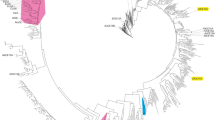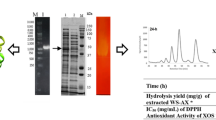Abstract
A new recombinant Aspergillus niger tannase (tannin acyl hydrolase) produced by the Penicillium verruculosum fungus has been studied. A strain with a high level of extracellular tannase (TAN2) secretion (80% of the total extracellular protein) was obtained by cloning the tan2 gene (PDB Acc. no: MT828303) into the recipient strain. The tannase enzyme preparation degraded tannins in black tea extracts. TAN2 was isolated in homogeneous form using chromatographic methods; the enzyme had a high activity with respect to gallotannin (53 U/mg) and less activity against propyl gallate (4.7 U/mg). Homogeneous TAN2 showed temperature and pH optima of 45°C and 3.5, respectively. At a temperature of 50°C, TAN2 retained above 80% of its activity for 3 h; at 60°C about 75% of its activity for 90 min was preserved; at 70°C, the enzyme was completely inactivated within 10 min. Tannase was characterized by a high tolerance to NaCl, the activity with respect to gallotannin exceeded 50% of the initial value in solutions with a salt concentration of up to 5 M. The tannase activity was stimulated by Ca2+, Mg2+, Zn2+, Mn2+, Cu2+, Cd2+, and Pb2+ by 3–64%, and inhibited by 4‒65% in the presence of Co2+, Fe3+ and Fe2+ ions.





Similar content being viewed by others

REFERENCES
Aguilar, C.N. and Gutierrez-Sanchez, G., Review: sources, properties, applications and potential uses of tannin acyl hydrolase, Food Sci. Technol. Int., 2001, vol. 7, pp. 373–382. https://doi.org/10.1106/69M3-B30K-CF7Q-RJ5G
Rajak, R.C. and Singh, A., Banerjee R. Biotransformation of hydrolysable tannin to ellagic acid by tannase from Aspergillus awamori, Biocatal. Biotransformation, 2017, vol. 35, pp. 27–34. https://doi.org/10.1080/10242422.2016.1278210
García, D.E., Glasser, W.G., Pizzi, A., et al., Modification of condensed tannins: from polyphenol chemistry to materials engineering, New J. Chem., 2016, vol. 40, pp. 36–49. https://doi.org/10.1039/C5NJ02131F
Sieniawska, E. and Baj, T., Tannins, in Pharmacognosy: Fundamentals, Applications and Strategies, Badal, S. and Delgoda, R., Eds., Amsterdam: Academic Press, 2017, p. 202.
Niho, N., Shibutani, M., Tamura, T., et al., Subchronic toxicity study of gallic acid by oral administration in F344 rats, Food Chem. Toxicol., 2001, vol. 39, pp. 1063–1070. https://doi.org/10.1016/S0278-6915(01)00054-0
Bajpai, B. and Patil, S., A new approach to microbial production of gallic acid, Braz. J. Microbiol., 2008, vol. 39, pp. 708–711. https://doi.org/10.1590/S1517-838220080004000021
Murugan, K. and Al-Sohaibani, S.A., Biocompatible removal of tannin and associated color from tannery effluent using the biomass and tannin acyl hydrolase (E.C.3.1.1.20) enzymes of mango industry solid waste isolate Aspergillus candidus MTTC 9628, Res. J. Microbiol., 2010, vol. 5, pp. 262–271. https://doi.org/10.3923/jm.2010.262.271
Bhoite, R.N. and Murthy, P.S., Biodegradation of coffee pulp tannin by Penicillium verrucosum for production of tannase, statistical optimization and its application, Food Bioprod. Process., 2015, vol. 94, pp. 727–735. https://doi.org/10.1016/J.FBP.2014.10.007
Thomas, R.L. and Murtagh, K., Characterization of tannase activity on tea extracts, J. Food Sci., 2006, vol. 50, pp. 1126–1129. https://doi.org/10.1111/j.1365-2621.1985.tb13026.x
Nie, G., Zheng, Z., Gong, G., et al., Characterization of bioimprinted tannase and its kinetic and thermodynamics properties in synthesis of propyl gallate by trans-esterification in anhydrous medium, Appl. Biochem. Biotechnol., 2012, vol. 167, pp. 2305–2317. https://doi.org/10.1007/s12010-012-9775-8
Belous, E., Maltabar, S.A., ans Galimova, A.Z., Composition for oral care, RF Patent no. 2416391, Byull. Izobret., 2011, no. 11.
Dhiman, S., Mukherjee, G., and Singh, A.K., Recent trends and advancements in microbial tannase-catalyzed biotransformation of tannins: a review, Int. Microbiol., 2018, vol. 21, pp. 175–195. https://doi.org/10.1007/s10123-018-0027-9
Sinitsyn, A.P., Sinitsyna, O.A., and Rozhkova, A.M., Production of industrially important enzymes based on the expression system of fungi Penicillium verruculosum, Biotekhnologiya, 2020, vol. 36, pp. 24–41. https://doi.org/10.31857/S0320972520060093
Chekushina, A.V., Cellulolytic enzyme preparations based on fungi Trichoderma, Penicillium, and Myceliophtora with increased hydrolytic activity, Extended Abstract of Cand. Sci. (Chem.) Dissertation, Moscow: Moscow State University, 2013.
Aslanidis, C. and de Jong, P.J., Ligation-independent cloning of PCR products (LIC-PCR), Nucleic Acids Res., 1990, vol. 18, pp. 6069–6074. https://doi.org/10.1093/nar/18.20.6069
Sambrook, J. and Russell, D.W., Preparation and transformation of competent E. coli using calcium chloride, Cold Spring Harb. Protoc., 2006, no. 1, article ID pdb.prot3932. https://doi.org/10.1101/pdb.prot3932
Penttilä, M., Nevalainen, H., Rättö, M., et al., A versatile transformation system for the cellulolytic filamentous fungus Trichoderma reesei, Gene, 1987, vol. 61, pp. 155–164. https://doi.org/10.1016/0378-1119(87)90110-7
Sharma, S., Bhat, T.K., and Dawra, R.K., A spectrophotometric method for assay of tannase using Rhodanine, Anal. Biochem., 2000, vol. 279, pp. 85–89. https://doi.org/10.1006/ABIO.1999.4405
Lowry, O.H., Rosebrough, N.J., Farr, A.L., and Randall, R.J., Protein measurement with the Folin phenol reagent, J. Biol. Chem., 1951, vol. 193, pp. 265–275.
James, P., Proteome Research: Mass Spectrometry, Heidelberg: Springer Verlag, 2001.
Hagerman, A.E. and Butler, L.G., Protein precipitation method for the quantitative determination of tannins, J. Agric. Food Chem., 1978, vol. 26, pp. 809–812. https://doi.org/10.1021/jf60218a027
Batra, A. and Saxena, R.K., Potential tannase producers from the genera Aspergillus and Penicillium, Process Biochem., 2005, vol. 40, pp. 1553–1557. https://doi.org/10.1016/j.procbio.2004.03.003
Iibuchi, S., Minoda, Y., and Yamada, K., Hydrolyzing pathway, substrate specificity and inhibition of tannin acyl hydrolase of Asp. oryzae No. 7, Agric. Biol. Chem., 1972, vol. 36, pp. 1553–1562. https://doi.org/10.1080/00021369.1972.10860437
Korotkova, O.G., Rubtsova, E.A., Shashkov, I.A., et al., Comparative analysis of the composition and properties of feed enzyme preparations, Catal. Prom., 2018, vol. 18, pp. 72–78. https://doi.org/10.18412/1816-0387-2018-4-72-78
Tomás-Cortázar, J., Plaza-Vinuesa, L., de las Rivas, B., et al., Identification of a highly active tannase enzyme from the oral pathogen Fusobacterium nucleatum subsp. polymorphum, Microb. Cell Fact., 2018, vol. 17, p. 33. https://doi.org/10.1186/s12934-018-0880-4
Hatamoto, O., Watarai, T., Kikuchi, M., et al., Cloning and sequencing of the gene encoding tannase and a structural study of the tannase subunit from Aspergillus oryzae, Gene, 1996, vol. 175, pp. 215–221. https://doi.org/10.1016/0378-1119(96)00153-9
Farias, G.M., Gorbea, C., Elkins, J.R., and Griffin, G.J., Purification, characterization, and substrate relationships of the tannase from Cryphonectria parasitica, Physiol. Mol. Plant Pathol., 1994, vol. 44, pp. 51–63. https://doi.org/10.1016/S0885-5765(05)80094-3
Barthomeuf, C., Regerat, F., and Pourrat, H., Production, purification and characterization of a tannase from Aspergillus niger LCF 8, J. Ferment. Bioeng., 1994, vol. 77, pp. 320–323. https://doi.org/10.1016/0922-338X(94)90242-9
Sharma, S., Bhat, T.K., and Dawra, R.K., Isolation, purification and properties of tannase from Aspergillus niger van Tieghem, World J. Microbiol. Biotechnol., 1999, vol. 15, pp. 673–677. https://doi.org/10.1023/A:1008939816281
Ramírez-Coronel, M.A., Viniegra-González, G., Darvill, A., and Augur, C., A novel tannase from Aspergillus niger with β-glucosidase activity, Microbiology, 2003, vol. 149, pp. 2941–2946. https://doi.org/10.1099/mic.0.26346-0
Gonçalves, H.B., Riul, A.J., Terenzi, H.F., et al., Extracellular tannase from Emericella nidulans showing hypertolerance to temperature and organic solvents, J. Mol. Catal. B Enzym., 2011, vol. 71, pp. 29–35. https://doi.org/10.1016/J.MOLCATB.2011.03.005
Riul, A.J., Gonçalves, H.B., Jorge, J.A., and Guimarães, L.H.S., Characterization of a glucose- and solventtolerant extracellular tannase from Aspergillus phoenicis, J. Mol. Catal. B Enzym., 2013, vol. 85–86, pp. 126–133. https://doi.org/10.1016/J.MOLCATB.2012.09.001
Aharwar, A. and Parihar, D.K., Talaromyces verruculosus tannase production, characterization and application in fruit juices detannification, Biocatal. Agric. Biotechnol., 2019, vol. 18, p. 101014. https://doi.org/10.1016/J.BCAB.2019.01.052
Mondal, K.C., Banerjee, D., Banerjee, R., and Pati, B.R., Production and characterization of tannase from Bacillus cereus KBR9, J. Gen. Appl. Microbiol., 2001, vol. 47, pp. 263–267. https://doi.org/10.2323/jgam.47.263
Banerjee, D., Mahapatra, M., and Bikas, P.R., Gallic acid production by submerged fermentation of Aspergillus aculeatus DBF9, J. Basic Microbiol., 2001, vol. 6, pp. 313–318. https://doi.org/10.3923/jm.2007.462.468
Jana, A., Maity, C., Halder, S.K., et al., Structural characterization of thermostable, solvent tolerant, cytosafe tannase from Bacillus subtilis PAB2, Biochem. Eng. J., 2013, vol. 77, pp. 161–170. https://doi.org/10.1016/J.BEJ.2013.06.002
Abdel-Naby, M.A., El-Tanash, A.B., and Sherief, A.D.A., Structural characterization, catalytic, kinetic and thermodynamic properties of Aspergillus oryzae tannase, Int. J. Biol. Macromol., 2016, vol. 92, pp. 803–811. https://doi.org/10.1016/J.IJBIOMAC.2016.06.098
Shao, Y., Zhang, Y.-H., Zhang, F., et al., Thermostable tannase from Aspergillus Niger and its application in the enzymatic extraction of green tea, Molecules, 2020, vol. 25, p. 952. https://doi.org/10.3390/molecules25040952
Kumar, C.S., Subramanian, R., and Rao, L.J., Application of enzymes in the production of RTD black tea beverages: a review, Crit. Rev. Food Sci. Nutr., 2013, vol. 53, pp. 180–197. https://doi.org/10.1080/10408398.2010.520098
Madeira, J.V., Macedo, J.A., and Macedo, G.A., Detoxification of castor bean residues and the simultaneous production of tannase and phytase by solid-state fermentation using Paecilomyces variotii, Bioresour. Technol., 2011, vol. 102, pp. 7343–7348. https://doi.org/10.1016/J.BIORTECH.2011.04.099
Jansman, A.J.M., Tannins in feedstuffs for simple-stomached animals, Nutr. Res. Rev., 1993, vol. 6, pp. 209–236. https://doi.org/10.1079/NRR19930013
Funding
This work was supported by the Ministry of Science and Higher Education of the Russian Federation.
Author information
Authors and Affiliations
Corresponding author
Ethics declarations
The authors declare that they have no conflicts of interest.
This article does not contain any studies involving animals performed by any of the authors.
This article does not contain any studies involving human participants performed by any of the authors outside the scope of their normal professional activities.
Additional information
Abbreviations: BSA, bovine serum albumin; CBH1, cellobiohydrolase 1; CBH2, cellobiohydrolase 2; CL, culture liquid; EP, enzyme preparation; MCC, microcrystalline cellulose; OD520, optical density at a wavelength of 520 nm; TAN2, spray-dried tannase preparation.
Rights and permissions
About this article
Cite this article
Osipov, D.O., Matys, V.Y., Nemashkalov, V.A. et al. Cloning, Isolation, and Properties of a New Recombinant Tannase from the Aspergillus niger Fungus. Appl Biochem Microbiol 58, 958–965 (2022). https://doi.org/10.1134/S000368382209006X
Received:
Revised:
Accepted:
Published:
Issue Date:
DOI: https://doi.org/10.1134/S000368382209006X



